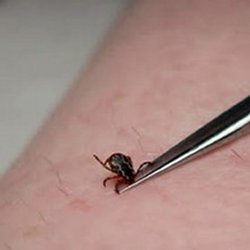
As tick populations grow and spread across the country, their prevalence is increasing the public’s risk for some troubling diseases. Of these diseases, say dermatologists from the American Academy of Dermatology, Lyme disease, Rocky Mountain spotted fever, Powassan virus and alpha-gal syndrome –a mysterious red meat allergy – are among the most serious. To remove a tick that is attached to your, Dr. Lindsay Strowd, MD, FAAD, recommends the following tips:
Use tweezers to remove the tick. Sterilize the tip of the tweezers using rubbing alcohol and grasp the tick as close to the skin’s surface as possible.
Pull upward with steady, even pressure. Avoid twisting, squeezing or crushing the tick, as this can cause its head or mouth to break off and remain in your skin. If this happens, use tweezers to remove the remaining parts. If you cannot remove the rest of the tick, see a board-certified dermatologist.
Dispose of the tick. Place it in a sealed bag or container; submerse the tick in alcohol; or wrap it tightly in tape. You may also want to save the tick in a sealed jar. That way, if you develop any symptoms after the bite, the tick can be tested for disease.
Clean the bite area with soap and water.
To prevent tick bites, Dr. Strowd recommends the following tips:
Walk in the center of trails. Avoid walking through heavily wooded and brushy areas with tall grass.
If you must walk through heavily wooded areas, wear long pants and long sleeves. Pull your socks up over your pants, and tuck your shirt into your pants to prevent ticks from crawling up your body. It’s also a good idea to wear light-colored clothes so that ticks can be spotted easily.
Use insect repellent that contains 20 to 30 percent DEET on exposed skin and clothing. Make sure to follow the product instructions. Parents should apply this product to their children, making sure to avoid the hands, eyes and mouth.
Examine your skin after spending time in heavily wooded or brushy areas. Conduct a full-body tick check to make sure that no ticks are crawling on you. Since ticks prefer warm, moist areas, be sure to check your armpits, groin and hair. You should also check your children and pets, as well as any gear you used outside.











